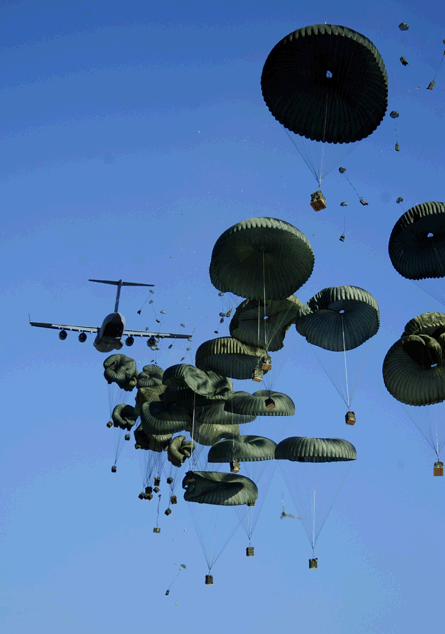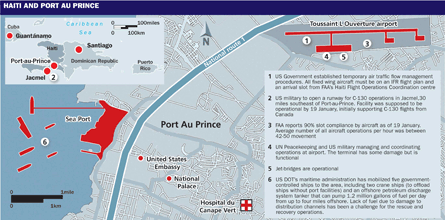In-flows of food, medical supplies, construction equipment and military troops - mostly from Brazil, Canada and the USA - continued to pour into the rubble of Haiti's earthquake-battered capital at the end of last week.
A steady stream of foreigners, meanwhile, poured out of Haiti by airlift, including 1,441 Canadians flown home by 20 January aboard Canada's newly acquired Boeing C-17s.
Reflecting the grim horror of the 7.3-magnitude quake's devastation, a Brazilian air force Lockheed Martin C-130 on 20 January flew home the bodies of 17 army comrades, members of a Brazilian battalion deployed to Port-au-Prince before the disaster under the United Nations' stabilisation mission.
 |
|---|
© USAF |
The scenes seemed tragically all too familiar, recalling the role of military aviation in the aftermath of the Indian Ocean tsunami in 2004, or Hurricane Katrina in 2005. Once again a national disaster has thrown a spotlight on the humanitarian assistance mission, highlighting military aviation's strengths and weaknesses.
Militaries around the world actively worked to be prepared for the next disaster. Arab states with no expeditionary mission, such as Qatar, have spent billions to acquire C-17s to serve primarily humanitarian purposes. Sweden joined NATO to form a C-17 operator consortium, which dispatched an airlifter to Port-au-Prince within a few days of the earthquake.
In the USA, Katrina boosted the US Army's motivation to fill out its force structure with the EADS North America UH-72 Lakota and the Alenia C-27J Spartan, although the latter has been transferred to US Air Force control. The USAF, for its part, attempted to acquire Boeing HH-47 Chinooks, but a series of acquisition blunders led to the cancellation of the combat search and rescue helicopter programme.
NEW INVESTMENT
While the scenes of Haiti's extended recovery remain fresh, the military response - dubbed Operation Hestia by the Canadians - will undoubtedly provide a platform for advocates of a new wave of investments.
The business case will focus as much on military aviation's successes as the breakdowns - real or perceived - in the timely arrival and distribution of aid.
In the hours after the earthquake, planners at US Southern Command started co-ordinating a massive relief operation based on a single runway at the Port-au-Prince airport that normally handles roughly 13 civilian flights a day.
The US Transportation Command assessment team concluded within one day of the earthquake that Haiti's single serviceable runway and apron could safely handle a maximum of two aircraft on the ground at any one time. The lack of additional airport capacity inside Haiti for the first week of the recovery effort would generate the sharpest criticism of the US military's decision-makers.
"We are constrained simply and purely by the size and the geometry of the airfield in Port-au-Prince," a senior military official says. "And it's a single runway. It's only about 9,600ft [2,930m]. And the maximum on the ground can normally only take seven or eight aircraft. Sometimes it's been constrained down to two or three. So the prioritisation of the aircraft that go in there has been important to us."
But the constraints were not exclusively limited to the runway. A shortage of helicopters would have limited the distribution of aid and supplies even if more runway capacity could be generated. As of 20 January, Southcom counted 49 helicopters at its disposal in Haiti. It was not clear if that counted Bell CH-146 Griffons operated by Canadian forces at Jacmel.
The number did not include 10 Bell Boeing MV-22 Ospreys that were due to arrive with the 24th Marine Expeditionary Unit late last week.
But the shortage of vertical lift answered the question why USAF airlifters such as C-130s and C-17s did not exploit their capability to land on dirt strips to establish new hubs.
"Some of those other airfields are even smaller than Port-au-Prince. And then in some cases, instead of solving the problem, you've exacerbated the problem, because now you have a hub at a distant location, where you're starting to build up supplies," the senior military official says. "And now you are entirely dependent on more ground mobility or more helicopters, both of which are at a premium."
By the end of last week, the USAF had grown Port-au-Prince runway operations from 30-40 aircraft a day to 130 a day. The movement of 2,000 soldiers from the 2nd brigade of the 82 Airborne Division and the 22nd Marine Expeditionary Unit took 28% of the airlift capacity that landed at Port-au-Prince in the first week. Meanwhile, Brazil used C-130s and a Boeing 707 KC-137 to send 200t of equipment and aid to Port-au-Prince in the first week.
Source: Flight International

















